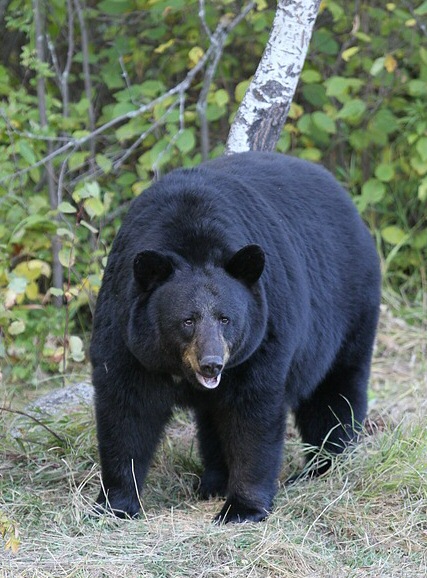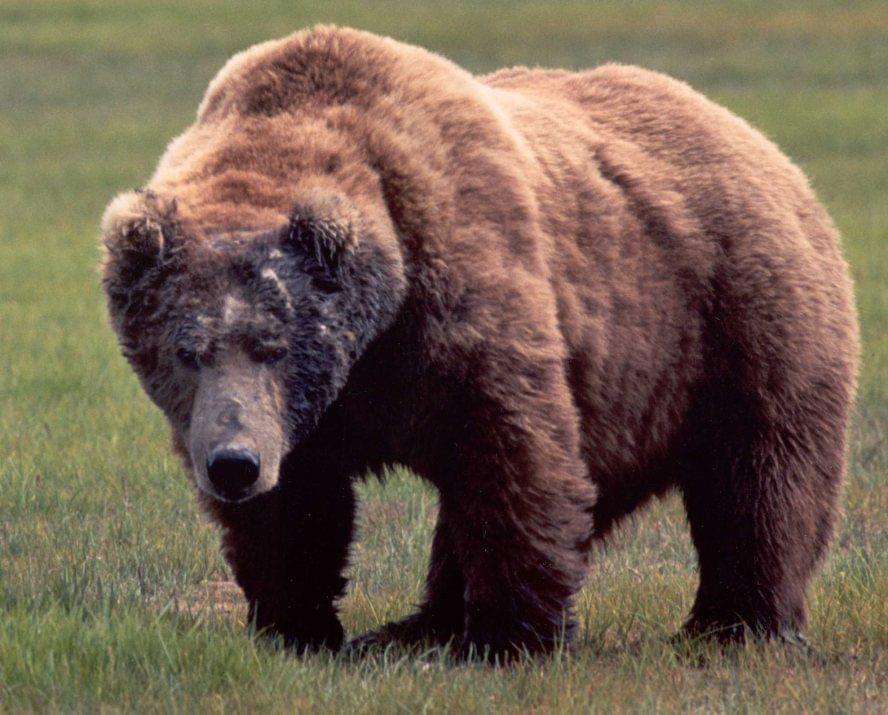Post by dinosauria101 on Sept 12, 2019 14:05:19 GMT 5
American Black Bear - Ursus americanus
The American black bear (Ursus americanus) is a medium-sized bear native to North America. It is the continent's smallest and most widely distributed bear species. American black bears are omnivores, with their diets varying greatly depending on season and location. They typically live in largely forested areas, but do leave forests in search of food. Sometimes they become attracted to human communities because of the immediate availability of food. The American black bear is the world's most common bear species.
American black bear weight tends to vary according to age, sex, health and season. Seasonal variation in weight is very pronounced: in autumn, their pre-den weight tends to be 30% higher than in spring, when black bears emerge from their dens. American black bears on the East Coast tend to be heavier on average than those on the West Coast, although American black bears follow Bergmann's rule and bears from the Northwest are often slightly heavier than the bears from the Southeast. Adult males typically weigh between 57–250 kg (126–551 lb), while females weigh 33% less at 41–170 kg (90–375 lb).[4][42]
In the state of California, studies have indicated that the average mass is 86 kg (190 lb) in adult males and 58 kg (128 lb) in adult females.[37] Adult American black bears in Yukon Flats National Wildlife Refuge in east-central Alaska were found to average 87.3 kg (192 lb) in males and 63.4 kg (140 lb) in females, whereas on Kuiu Island in southeast Alaska (where nutritious salmon are readily available) adult American black bears averaged an estimated 115 kg (254 lb).[43][44] In Great Smoky Mountains National Park, adult males averaged 112 kg (247 lb) and adult females averaged 47 kg (104 lb) per one study.[45] In one of the largest studies on regional body mass, bears in British Columbia averaged 73.7 kg (162 lb) in 89 females and 103.1 kg (227 lb) in 243 males.[46] In Yellowstone National Park, a population study found that adult males averaged 119 kg (262 lb) and adult females averaged 67 kg (148 lb).[47] Black bears in north-central Minnesota averaged 69.9 kg (154 lb) in 163 females and 124.95 kg (275 lb) in 77 males.[48] In New York, the two sexes reportedly average 135 kg (298 lb) and 74 kg (163 lb), respectively.[49] It was found in Nevada and Lake Tahoe region that black bears closer to urban regions were significantly heavier than their arid-country dwelling counterparts, with males near urban areas averaging 138 kg (304 lb) against wild-land males which averaged 115.5 kg (255 lb) whereas peri-urban females averaged 97.9 kg (216 lb) against the average of 65.2 kg (144 lb) in wild-land ones.[50] In Waterton Lakes National Park, Alberta adults reportedly averaged 125 to 128 kg (276 to 282 lb).[51] Adults typically range from 120 to 200 cm (47 to 79 in) in head-and-body length, and 70 to 105 cm (28 to 41 in) in shoulder height. The typically small tail is 7.7–17.7 cm (3.0–7.0 in) long.[39][52][53][54] Although they are the smallest bear species in North America, large males exceed the size of other bear species, except the brown bear and the polar bear.[39]

Grizzly Bear (sow) - Ursus arctos horribilis
The grizzly bear (Ursus arctos ssp.), also known as the North American brown bear, is a large population of the brown bear inhabiting North America.
Multiple morphological forms sometimes recognized as subspecies exist, including the mainland grizzly (Ursus arctos horribilis), Kodiak bear (U. a. middendorffi), peninsular grizzly (U. a. gyas), and the recently extinct California grizzly (U. a. californicus†)[1][2] and Mexican grizzly bear (U. a. nelsoni†). On average bears near the coast tend to be larger while inland grizzlies tend to be smaller.
Most adult female grizzlies weigh 130–180 kg (290–400 lb), while adult males weigh on average 180–360 kg (400–790 lb). Average total length in this subspecies is 198 cm (6.50 ft), with an average shoulder height of 102 cm (3.35 ft) and hindfoot length of 28 cm (11 in).[16] Newborn bears may weigh less than 500 grams (1.1 lb). In the Yukon River area, mature female grizzlies can weigh as little as 100 kg (220 lb). One study found that the average weight for an inland male grizzly was around 272 kilograms (600 lb) and the average weight for a coastal male was around 408 kilograms (900 lb). For a female, these average weights would be 136 kilograms (300 lb) inland and 227 kilograms (500 lb) coastal, respectively.[17] On the other hand, an occasional huge male grizzly has been recorded which greatly exceeds ordinary size, with weights reported up to 680 kg (1,500 lb).[18] A large coastal male of this size may stand up to 3 metres (9.8 ft) tall on its hind legs and be up to 1.5 metres (4.9 ft) at the shoulder.[19]
Although variable in color from blond to nearly black, grizzly bear fur is typically brown with darker legs and commonly white or blond tipped fur on the flank and back.[20] A pronounced hump appears on their shoulders; the hump is a good way to distinguish a grizzly bear from a black bear, as black bears do not have this hump. Aside from the distinguishing hump a grizzly bear can be identified by a "dished in" profile of their face with short, rounded ears, whereas a black bear has a straight face profile and longer ears.[21] A grizzly bear can also be identified by its rump, which is lower than its shoulders, while a black bear's rump is higher.[21] A grizzly bear's front claws measure about 2–4 inches in length and a black bear's measure about 1–2 inches in length.[21]

Credit to Wikipedia, grizzly bear image by user Traveler100
The American black bear (Ursus americanus) is a medium-sized bear native to North America. It is the continent's smallest and most widely distributed bear species. American black bears are omnivores, with their diets varying greatly depending on season and location. They typically live in largely forested areas, but do leave forests in search of food. Sometimes they become attracted to human communities because of the immediate availability of food. The American black bear is the world's most common bear species.
American black bear weight tends to vary according to age, sex, health and season. Seasonal variation in weight is very pronounced: in autumn, their pre-den weight tends to be 30% higher than in spring, when black bears emerge from their dens. American black bears on the East Coast tend to be heavier on average than those on the West Coast, although American black bears follow Bergmann's rule and bears from the Northwest are often slightly heavier than the bears from the Southeast. Adult males typically weigh between 57–250 kg (126–551 lb), while females weigh 33% less at 41–170 kg (90–375 lb).[4][42]
In the state of California, studies have indicated that the average mass is 86 kg (190 lb) in adult males and 58 kg (128 lb) in adult females.[37] Adult American black bears in Yukon Flats National Wildlife Refuge in east-central Alaska were found to average 87.3 kg (192 lb) in males and 63.4 kg (140 lb) in females, whereas on Kuiu Island in southeast Alaska (where nutritious salmon are readily available) adult American black bears averaged an estimated 115 kg (254 lb).[43][44] In Great Smoky Mountains National Park, adult males averaged 112 kg (247 lb) and adult females averaged 47 kg (104 lb) per one study.[45] In one of the largest studies on regional body mass, bears in British Columbia averaged 73.7 kg (162 lb) in 89 females and 103.1 kg (227 lb) in 243 males.[46] In Yellowstone National Park, a population study found that adult males averaged 119 kg (262 lb) and adult females averaged 67 kg (148 lb).[47] Black bears in north-central Minnesota averaged 69.9 kg (154 lb) in 163 females and 124.95 kg (275 lb) in 77 males.[48] In New York, the two sexes reportedly average 135 kg (298 lb) and 74 kg (163 lb), respectively.[49] It was found in Nevada and Lake Tahoe region that black bears closer to urban regions were significantly heavier than their arid-country dwelling counterparts, with males near urban areas averaging 138 kg (304 lb) against wild-land males which averaged 115.5 kg (255 lb) whereas peri-urban females averaged 97.9 kg (216 lb) against the average of 65.2 kg (144 lb) in wild-land ones.[50] In Waterton Lakes National Park, Alberta adults reportedly averaged 125 to 128 kg (276 to 282 lb).[51] Adults typically range from 120 to 200 cm (47 to 79 in) in head-and-body length, and 70 to 105 cm (28 to 41 in) in shoulder height. The typically small tail is 7.7–17.7 cm (3.0–7.0 in) long.[39][52][53][54] Although they are the smallest bear species in North America, large males exceed the size of other bear species, except the brown bear and the polar bear.[39]

Grizzly Bear (sow) - Ursus arctos horribilis
The grizzly bear (Ursus arctos ssp.), also known as the North American brown bear, is a large population of the brown bear inhabiting North America.
Multiple morphological forms sometimes recognized as subspecies exist, including the mainland grizzly (Ursus arctos horribilis), Kodiak bear (U. a. middendorffi), peninsular grizzly (U. a. gyas), and the recently extinct California grizzly (U. a. californicus†)[1][2] and Mexican grizzly bear (U. a. nelsoni†). On average bears near the coast tend to be larger while inland grizzlies tend to be smaller.
Most adult female grizzlies weigh 130–180 kg (290–400 lb), while adult males weigh on average 180–360 kg (400–790 lb). Average total length in this subspecies is 198 cm (6.50 ft), with an average shoulder height of 102 cm (3.35 ft) and hindfoot length of 28 cm (11 in).[16] Newborn bears may weigh less than 500 grams (1.1 lb). In the Yukon River area, mature female grizzlies can weigh as little as 100 kg (220 lb). One study found that the average weight for an inland male grizzly was around 272 kilograms (600 lb) and the average weight for a coastal male was around 408 kilograms (900 lb). For a female, these average weights would be 136 kilograms (300 lb) inland and 227 kilograms (500 lb) coastal, respectively.[17] On the other hand, an occasional huge male grizzly has been recorded which greatly exceeds ordinary size, with weights reported up to 680 kg (1,500 lb).[18] A large coastal male of this size may stand up to 3 metres (9.8 ft) tall on its hind legs and be up to 1.5 metres (4.9 ft) at the shoulder.[19]
Although variable in color from blond to nearly black, grizzly bear fur is typically brown with darker legs and commonly white or blond tipped fur on the flank and back.[20] A pronounced hump appears on their shoulders; the hump is a good way to distinguish a grizzly bear from a black bear, as black bears do not have this hump. Aside from the distinguishing hump a grizzly bear can be identified by a "dished in" profile of their face with short, rounded ears, whereas a black bear has a straight face profile and longer ears.[21] A grizzly bear can also be identified by its rump, which is lower than its shoulders, while a black bear's rump is higher.[21] A grizzly bear's front claws measure about 2–4 inches in length and a black bear's measure about 1–2 inches in length.[21]

Credit to Wikipedia, grizzly bear image by user Traveler100





